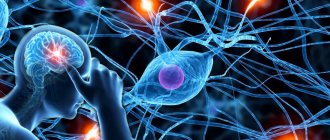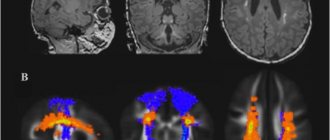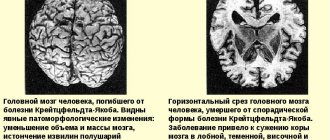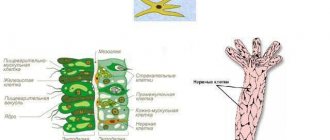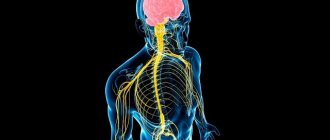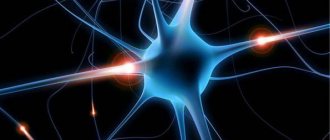Diseases that start with the letter “M”: Lesser chorea, Slow infections of the central nervous system, Medulloblastoma, Herniated disc, Thoracic disc herniation, Lumbar disc herniation, Cervical disc herniation, Intercostal neuralgia, Meningeal syndrome, Meningioma, Meningitis, Meningococcal meningitis, Meningomyelitis , Meningoencephalitis, Metabolic myopathy, Metastatic brain tumors, Metachromatic leukodystrophy, Weather sensitivity, Myasthenia gravis, Migraine stroke.
The human central nervous system (CNS) is the main mechanism through which organ activity is controlled.
Any failure of this well-functioning operation leads to adverse consequences for the human body.
Infections and the diseases caused by them can disrupt the functioning of the central nervous system.
By infection (in a general sense) we mean the impact of foreign microorganisms on the human body, due to the ingress of viruses, bacteria, and parasites.
General concept
Slow infections of the central nervous system - damage to the human central nervous system by special viruses (virions - virus particles, prions - virus-like proteins). It is observed after a long incubation period, during which the development of infection proceeds unnoticed. Diagnosis of such diseases is possible through examination by a neurologist, as well as:
- using a tomograph,
- taking fluid from the spinal cord
- blood test for the presence of antiviral antibodies.
The first information mentioning these viruses dates back to 1954. An Icelandic scientist described unusual diseases in sheep, as a result of which the central nervous system of the animals was affected. He called them slow infections. In 1957, the inhabitants of New Guinea were exposed to an unknown disease (called "kuru"), the symptoms and course of which were exactly the same as slow infections. This disease topped the list of lesions of the nervous system, which is growing. There is rather scant information about the disease. Some forms appear more often and do not depend on the place of residence of a person, others only in a certain area.
Causes of diseases
Many years of research have identified the causative agents of these infections. The main cause of damage to the nervous system turned out to be two factors:
- Viruses. Diseases of this group can occur after a long (several years) existence in the body of a virus remaining after a person has suffered from an illness. This could be: measles, rubella, common herpes, polyomavirus, cytomegalovirus, flavivirus. Viruses are transmitted by airborne droplets, food, blood, or from mother to fetus during pregnancy and fetal development.
- Prions. These are special proteins that have a certain set of properties, like viruses, but structurally they do not have DNA or RNA. Pathology with this pathogen occurs due to the transformation of the same “good” proteins of nerve cells into “damaged” ones.
Infection occurs due to:
- eating undercooked meat that has been contaminated;
- by transfusion of contaminated blood;
- as a result of transplantation of organs or tissues that have pathological prions.
Scientists do not know the exact reason why the disease virus stays inside the human body for a long time. Opinions agree on the poor functioning of the immune system and the insufficient amount of antibodies produced, which activates the process of proliferation of the remaining viral cells.
Bacterial infections
A huge number of pathogens related to bacterial infections can affect the brain. Diseases such as meningitis, encephalitis or brain abscess may well be caused by such “ordinary” pathogens as pneumococcus, staphylococcus, and enterobacteria. But this can only happen if:
- damage to the bones of the skull, with disruption of the integrity of the membranes of the brain;
- introduction of pathogens during neurosurgical operations;
- the presence of a purulent focus in the body and weakened immunity.
However, with other pathogens the situation is different.
Meningococcal infection is a traditional neuroinfection that affects the brain. The peak incidence is observed in the autumn-winter period, when the immune system is reduced due to frequent hypothermia and lack of vitamins. If the immune system is normal, then you will limit yourself to ordinary nasopharyngitis; otherwise, the likelihood of getting meningitis or meningoencephalitis increases.
Symptoms of meningococcal infection
- fever,
- increase in body temperature to 39-40° C.
- chills,
- headache
- weakness
- neck muscle tension
- nausea,
- vomit,
specific symptoms
- A red-violet rash protruding above the surface of the skin, the elements of which resemble a star in shape
- The disease begins very acutely (often you can specify a specific time (hour) when the person fell ill)
- Treatment must begin within 24 hours while the person is conscious, otherwise he may fall into a coma.
Mycobacterium tuberculosis, among other things, can also affect the brain. Children, elderly people and people suffering from immunodeficiency are more often affected.
The symptoms of the onset of the disease are not clearly expressed, most often it is general weakness, malaise, lack of appetite, headache and irritability, body temperature is subfebrile (the temperature rises over a long period of time within 37.1 - 38°C.). Subsequently, “usual” meningeal symptoms appear.
Afterwards, neurological disorders appear - paresis and paralysis of the facial nerve, oculomotor muscles, dizziness. Mental disorders occur against the background of neurological disorders.
Neurosyphilis, now almost never occurs, but before the discovery of penicillin it formed the basis of the work of neurologists. Neurosyphilis comes in several types:
- Asymptomatic, occurs without any special symptoms, the disease can only be detected by testing.
- Meningitis - often appears during the first year of the disease, manifested by disturbances in the functioning of cranial nerves and increased intracranial pressure (ICP).
- Cerebrovascular - occurs mainly in the 2-5th year of the disease and can lead to a stroke or transform into tabes dorsalis or progressive paralysis.
- Progressive paralysis is a disease that was also called “crazy paralysis.” Occurs 15-20 years after infection and first manifests itself with mental symptoms, then muscle paralysis occurs and progresses, which ultimately leads to death.
- Congenital, which, strictly speaking, affects the entire body and is characterized by multiple defects in the development of the child.
- Gumma of the brain - manifests itself as a space-occupying formation. Symptoms include increased ICP and focal symptoms, depending on the location of the gumma.
An unpleasant feature of the disease is its difficult diagnosis.
The mechanism of the onset of the disease and its development
A common feature of all slow viruses is long-term pathological development and proliferation of the virus in brain tissue. Infectious agents appear in the brain tissue after the disease (often common in the fetus or in children who become ill at an early age), and then subside and become inactive. Some time after their activation, the reasons for which remain unknown, inflammatory processes begin, leading to pathologies of the central nervous system. When a prion enters a cell of the body, it begins to interact with a similar healthy protein, as a result of which it changes it to “infected”.
Prions take time to enter brain cells and change proteins. This causes a long latent period of development of the disease. As a result, metabolic changes occur in the body, which leads to the death of neurons - cells of the nervous system. The internal picture of the course of slow infections is varied. If the causative agent is a virus, then, as a rule, perivascular lymphocytic infiltrates or astrocytoma foci are formed. Also, central nervous system tissues hide foci of gliosis.
Differentiation of signs of infectious diseases of the nervous system
Infectious diseases of the nervous system, in PDF files with descriptions of the forms of the disease, are classified depending on the lesion. Depending on which component of the nervous system is negatively affected, the following forms of the disease are distinguished:
- myelitis is characterized by damage to the spinal cord. Most often, the infection enters the body through the blood. Specific manifestations of myelitis are pain in the limbs;
- meningitis occurs in patients with inflammation of the meninges. A characteristic manifestation of this form of infection is a severe headache. General manifestations of the infectious process during meningitis can be supplemented by tachycardia, skin rash, muscle soreness;
- Encephalitis is characterized by infection of the brain. This condition is characterized by both general symptoms and specific manifestations: convulsions, impaired consciousness, deep coma.
Comprehensive diagnostics carried out at the Yusupov Hospital allow specialists to determine which part of the nervous system is damaged by infection. Infectious diseases of the nervous system, neurology contains a full description of which, can be successfully treated at the initial stage, when a person has no signs of cognitive impairment.
Symptoms
The incubation period is characterized by an asymptomatic course of the disease. The next stage (prodromal), when the disease has not yet developed, but the latent incubation period is over. It is expressed in the patient’s behavior: constant irritability, emotional instability, absent-minded behavior, problems with coordination. The last stage (manifestation) consists of the clear expression and development of symptoms of the disease. Manifestation of the disease:
- in involuntary impulsive movements of the body or vice versa, there is a restriction in normal movement;
- Greater muscle weakness or paralysis may occur;
- there is a decrease in mental abilities;
- disruption of the facial nerves, and, as a consequence, the development of hearing loss, decreased vision, and problems with swallowing;
- delirium, hallucinations, confusion;
- There are problems with speech up to its complete absence.
Each disease has its own symptoms and characteristic features. A distinctive feature of all slow CNS infections is the length of the incubation period. And then the very rapid development of the disease, which in just a year (in rare cases up to 4 years), brings the human body to the last stage (thermal). Here the patient becomes paralyzed, a complete mutation of intellectual abilities occurs, and often falls into a coma. Mortality in such diseases occurs in 100% of cases.
Diagnostics
Determining the presence of the disease is quite difficult. This is due to the difficulty of identifying the pathogen, as well as the rarity and lack of thorough study of pathologies. However, there are a number of diagnostic tests that can help identify the disease:
- Anamnesis, that is, collecting information through questioning: about previously suffered viral diseases (including in the embryonic state during maternal illness); whether there was a tissue transplant. The existing symptoms are compared with the normal healthy state of the body.
- Neurological examination - a study of coordination, motor and sensory systems, and reflex state is carried out. Based on the results obtained, a conclusion is made about damage to the brain tissue and the entire nervous system.
- Neuroimaging is performed using special equipment. Diagnosis is carried out on the basis of magnetic resonance imaging, computed tomography and MSCT of the cerebral cortex. The tomograph shows a complete picture in which one can trace infectious damage to brain cells in the form of their atrophy (death), demyelination (destruction of the myelin sheath of nerve fibers) and degeneration (damage to neurons). If dilated ventricles are detected, we should talk about hydrocephalus.
- Cerebrospinal fluid examination is done using a puncture sample. In the absence of inflammatory processes in fluid tests, infections of the nervous system can be excluded. An analysis is also carried out to detect the DNA of infectious agents and the presence of antiviral antibodies. Due to the viral pathogen, the disease can be diagnosed in 70-90% of those studied.
- A blood test for the presence of antibodies is effective only for a viral pathogen. Determined by anti-measles and anti-rubella antibodies.
- Brain biopsy is done in extreme cases when other diagnostic tests have not given the desired result.
Also, for a complete examination, examinations by other specialists are prescribed: ophthalmologist, infectious disease specialist, geneticist, psychiatrist. When diagnosing, it is necessary to exclude other diseases not associated with damage to the tissues of the central nervous system.
Diseases of the central and peripheral nervous system
The human nervous system is anatomically divided into two parts: central (CNS) and peripheral (PNS). This is a complex structure that permeates all the organs and tissues of our body. It is thanks to it that self-regulation of all vital functions of the body is possible, as well as the perception, storage and processing of received information. Nerve impulses allow us to sense and perceive the world around us in all its diversity. However, due to the complexity and fragility of the structure of the nervous system, injuries, damage and diseases (including genetic ones) can disrupt its coordinated work.
The most common diseases of the nervous system:
- Acute pathologies affecting cerebral vessels. These include stroke, dyscirculatory encephalopathy, intracerebral hemorrhages, intracranial arterial aneurysms, etc.
- Consequences of traumatic brain injuries
- Infectious diseases of the central nervous system: meningitis, encephalitis, brain abscess, polio and others
- Multiple sclerosis
- Epilepsy
- Age-related diseases of the nervous system - Parkinson's disease and Alzheimer's disease
- Osteocondritis of the spine
- Genetic and inherited diseases of the nervous system. This group usually includes pathologies such as Leigh syndrome, Tourette syndrome, spinal muscular atrophy, Huntington and Batten diseases, etc.
- Various disorders in the functioning of the peripheral nervous system: neuralgia, neuritis, lumbodynia and others.
Symptoms of nervous system diseases
Due to the variety of forms and types of neurological disorders, it can be difficult to identify common symptoms, but there are a number of the most common signs that may indicate the development of a disease of the nervous system. These include:
- Sleep disorders - insomnia
- Increased anxiety and irritability
- Decreased performance, lethargy, drowsiness
- Problems with remembering, decreased attentiveness
- The emergence of obsessive thoughts and phobias
- Nervous tics, involuntary muscle contractions
- Headaches, migraines, pain in limbs
- Frequent changes in blood pressure
- Smell disorders, taste disorders, vision problems
Treatment of diseases of the nervous system in a sanatorium
In case of disturbances in the functioning of the central or peripheral nervous system, depending on individual indications and contraindications, the patient may be prescribed various procedures. Most often, the treatment program for diseases of the nervous system includes balneotherapy, water and mud therapy, various types of manual and machine massage, and physiotherapy. In addition, while relaxing in a sanatorium, it is much easier to adhere to a daily schedule of activity and sleep, follow the diet and other instructions of the attending physician.
Treatment
It should be noted right away that there is no treatment that cures these infections. All developed methods and drugs have failed to cure a person from this disease. Therefore, the prescribed therapy can only alleviate the condition of patients and sometimes slightly slow down the irreversible processes occurring in the central nervous system.
Medicines relieve cramps, relieve swelling, and vitamins and psychotropic drugs are also prescribed. Scientists continue to research the disease and are looking for a treatment that can save people from this terrible disease.
Methods of prevention and prognosis
Even today, slow infections of the central nervous system are one of the incurable diseases. Once symptoms appear, the average lifespan for a person is approximately 1-2 years, after which irreversible damage and death of brain cells occurs. People with Gerstmann syndrome have the longest life expectancy, up to 5 years.
All disease prevention is aimed at maintaining the necessary level of immunity to fight viruses through vaccination (for example, to prevent the measles and rubella virus). What seemed to be infections caused by prions - no methods of prevention were found.
Treatment of neuroinfections
Based on the diagnostic studies performed, the clinic’s specialists will choose intensive therapy aimed at:
- Elimination of the causative agent of the disease. For this, the doctor prescribes the most modern antibiotics, antivirals, interferons, and immunoglobulins.
- Eliminating the source of infection. For example, if the source is in the maxillary sinuses, it is necessary to put them in order.
- Restoration of anti-infective immunity. For this purpose, the neurologist will prescribe special medications.
- Stimulating the functions of affected areas of the central nervous system with the help of effective medications.
